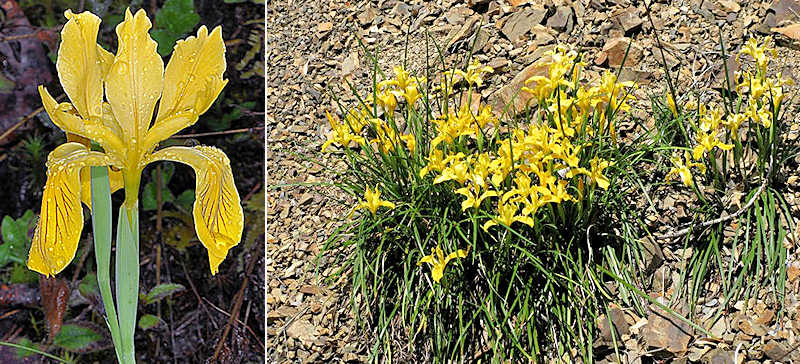Wild PCN iris - four unique species:
3. Golden iris - Iris innominata

Photos: (L) © Gerald Carr, Cow Creek Road, Douglas Co., Oregon; (R) Debby Cole, Glendale-Powers Road, Douglas County, Oregon

Range: An inland iris, seldom found within sight of the ocean; locally abundant at higher levels in the Klamath mountains of southwestern Oregon; its distribution in coastal regions of southwest Oregon and possibly northwestern California needs to be reevaluated; 400-2,000 meters elevation.
Original material: Rogue River area, Curry County, Oregon 1929.
Key identifying features:
- Floral tube slender, funnel-shaped at top, medium length (around ¾ inch).
- Spathes short, broad and closed around ovary.
- Ovary rounded in cross section.
- Flower parts rather broad and rounded.
- Numerous flowers on each mature clump.
- Leaves very slender, grass-like, dark glossy green above, lighter matte below, long-lasting.
- Mature plants form dense, compact evergreen tussocks.
Flower color: Usually pale to bright golden-yellow, with darker veins; other colors include white, grades of pale cream-yellow to orange.
Habitat: Woodland settings, preferring open locations with well-drained soil; in fir/pine forests; sunny meadows or other well-exposed sites on lightly shaded slopes.
Name: By Louis Forniquet Henderson, calling attention to this previously known but until then unnamed (innominatus) iris.
Comments: This is one of the most attractive PCIs, often used for hybridizing because of its clump-forming habit with dense, compact evergreen leaf growth and abundant flowers on each plant. One typical plant seen along Reuben Road in southern Oregon covered just one square foot of ground, and had 68 bright golden-yellow flowers all open at the same time. Garden breeders often cross it with I. douglasiana. Many of the plants labled "Iris innominata" in nurseries are actually hybrids.
The "Del Norte County Iris"
Although sometimes appearing as a common name for Iris innominata, this would appear an unfortunate choice. The golden iris occurs mostly, perhaps entirely, in Oregon, where it was first described. The southern edge of its range may, or may not, extend southward along the Klamath Mountains into California's Del Norte County. Some accounts describe the flower color in California as purple or lavender. If so, it may be that the "Del Norte County Iris" is actually Thompson's Iris - Iris innominata's closest relative..